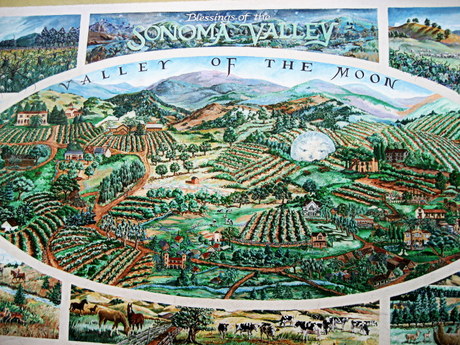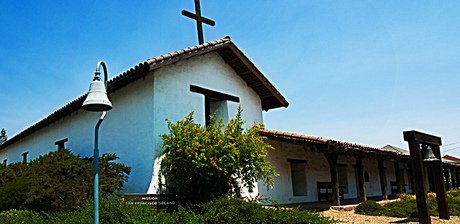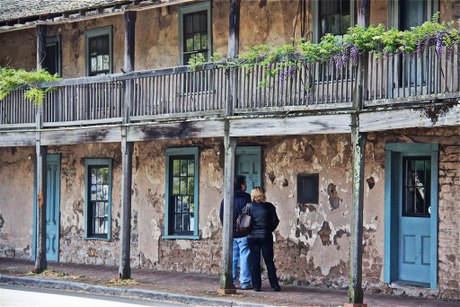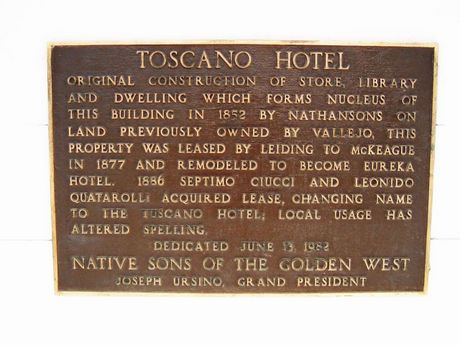Discover the Adventure
Sonoma Plaza History
Sonoma Plaza History:
Explore Sonoma State Historic Park
Sonoma Plaza history is really the history of the state of California. It speaks to the contributions of our Native Americans, the Spanish and Mexican cultures, Russian influences, and to the pioneering spirit that forged California.
It's also the site of one of the shortest revolutions in the history of the United States - the Bear Flag Revolt, as it was called, lasted only 26 days. But we're getting ahead of ourselves...
Although the Sonoma area had been home to the Coast Miwok tribes long before Europeans arrived, the history of the town of Sonoma itself began with the founding of Mission San Francisco Solano in 1823, the northernmost Franciscan mission in Alta California.
Do you have a favorite
NorCal story?
From a family visit from years ago to something
you discovered last weekend,
Share it with
the rest of us - we'd love to learn about it!
HotelsCombined.com - compare prices from all the best hotel booking sites while you explore Sonoma Plaza history:

Sonoma Plaza History: The Bear Flag Revolt
|
|
During the years the mission was active, General Mariano Guadalupe Vallejo was charged by the Mexican government with the task of maintaining law and order in the area. This meant keeping an eye on the native tribes, the Russians at Fort Ross, and the several dozen American and British immigrants who had found their way to El Pueblo de Sonoma. During the years the mission was active, General Mariano Guadalupe Vallejo was charged by the Mexican government with the task of maintaining law and order in the area. This meant keeping an eye on the native tribes, the Russians at Fort Ross, and the several dozen American and British immigrants who had found their way to El Pueblo de Sonoma. As it turned out - and as so often happens - General Vallejo had a lot less trouble from both the Native Americans and the Russians together, than he did with the Americans and the Brits. |
As it turned out - and as so often happens - General Vallejo had a lot less trouble from both the Native Americans and the Russians together, than he did with the Americans and the Brits.
The mission and General Vallejo ruled the area in relative peace for just over 20 years.
But In 1846, less than two years before gold was discovered in
California, those few dozen rag-tag Anglo-Americans who lived around
The Plaza - possibly at the instigation of American Army officer, John C. Fremont - hatched a plot to snatch California away from Mexico and form their own republic.
On June 14, 1846, these Americans took the following actions:
- They proclaimed independence from Mexico and declared themselves to be a new and free country
- They arrested General Mariano Guadalupe Vallejo, his brother, and his brother-in-law, - as the local representatives of the Mexican government - and shipped them off to Sutter's Fort for imprisonment
- They raised a flag with a grizzly bear symbol, signaling the birth of a new republic
- They declared Sonoma to be the Capital of their newly formed California Republic
This series of actions was later dubbed the Bear Flag Revolt.
Now we have to keep in mind that this was long before the Internet, cell phones, Facebook, and Twitter! Unbeknownst to the Bear Flaggers, the United States had already declared war on Mexico back in May, a month before the revolt.
The Sonoma Californians didn't receive word about the war until mid-July. When they finally heard about it, they thought it prudent to abandon their infant Republic in favor of joining the war on the side of the United States lest they find themselves warring not only with Mexico but with the U.S. as well!
Thus the California Republic was quite possibly the shortest-lived Republic in the history of the world, lasting a mere 26 days.
But it does seem, one way or another, that California was destined to become the 31st state in the Union, and today's state flag honors the efforts of the Bear Flaggers with its star, its grizzly bear, and the words, "California Republic."
The mission and General Vallejo ruled the area in relative peace for just over 20 years.
But In 1846, less than two years before gold was discovered in
California, those few dozen rag-tag Anglo-Americans who lived around
The Plaza - possibly at the instigation of American Army officer, John
C. Fremont - hatched a plot to snatch California away from Mexico and
form their own republic.
On June 14, 1846, these Americans took the following actions:
- They proclaimed independence from Mexico and declared themselves to be a new and free country
- They arrested General Mariano Guadalupe Vallejo, his brother, and his brother-in-law, - as the local representatives of the Mexican government - and shipped them off to Sutter's Fort for imprisonment
- They raised a flag with a grizzly bear symbol, signaling the birth of a new republic
- They declared Sonoma to be the Capital of their newly formed California Republic
This series of actions was later dubbed the Bear Flag Revolt.
Now we have to keep in mind that this was long before the Internet, cell phones, Facebook, and Twitter! Unbeknownst to the Bear Flaggers, the United States had already declared war on Mexico back in May, a month before the revolt.
The Sonoma Californians didn't receive word about the war until mid-July. When they finally heard about it, they thought it prudent to abandon their infant Republic in favor of joining the war on the side of the United States lest they find themselves warring not only with Mexico but with the U.S. as well!
Thus the California Republic was quite possibly the shortest-lived Republic in the history of the world, lasting a mere 26 days.
But it does seem, one way or another, that California was destined to become the 31st state in the Union, and today's state flag honors the efforts of the Bear Flaggers with its star, its grizzly bear, and the words, "California Republic."

Sonoma Plaza History:
Sonoma State Historic Park Buildings
Sonoma Plaza History: Sonoma Mission
Obviously the history of California started long before the Sonoma Plaza historical events that led up to statehood!
First came the Indian peoples who populated the land. Like most Native Americans prior to European settlement, they lived off the land in partnership with nature. Not to say they did nothing to change their environment - for instance, it's becoming more accepted that the First Americans used fire to keep underbrush and small trees controlled in their forests.
But that all began to change with the coming of Spanish explorers in the early 1500s, and especially so when Spanish settlements began erupting in the mid-1700s. From that time forward, Native Americans saw their land come under the auspices of seven different foreign governments.
By the early 1800s it was the Mexicans who were in control, and they had built the Plaza and many of the buildings which today represent Sonoma Plaza history and belong to Sonoma State Historic Park.
Father Jose Altimira of Spain established and consecrated the Sonoma Mission site in 1823 without the permission or authorization of the Church.
It turned out to be the last of the California Missions, but ultimately the most successful - though not under Altimira's reign. (More about that in a moment.)
In 1825 the complex consisted of a temporary chapel made of wood and the Padres' Quarters, the low adobe wing you'll see to the east of the current chapel. The Padres' Quarters, although partially reconstructed, is the oldest building in Sonoma.
Eventually other buildings were added, not all of which exist today: a storehouse, workshops for teaching the natives various crafts, and of course, the original adobe church that was east of the Padres' Quarters. (The current-day chapel was built in the 1830s by General Vallejo after Mexico secularized the Missions.)
Join one of the Docent-led Mission Tours to learn about Native American life, and Mission life, as well as to view the paintings and artifacts. If you're there on a Thursday, you might see school children learning to make Native American baskets and candles.
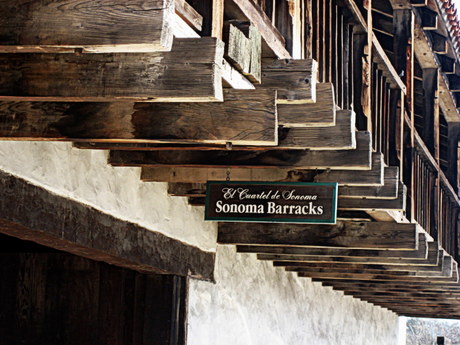 Sonoma Barracks by Wolf Rosenberg
Sonoma Barracks by Wolf RosenbergSonoma Plaza History: Sonoma Barracks
Although Father Altimira was a good administrator in terms of getting vineyards planted and constructing buildings, he treated his Indians cruelly under the guise of civilizing them, doling out floggings and imprisonment at will.
As will happen, the Natives were inspired to rebel against this treatment and attacked the Mission, expressing their displeasure by burning down his church.
The good friar fled, ultimately returning to Spain, and the Mission was completed by Father Buenaventura Fortuni.
Under Fortuni's excellent management, the Mission flourished and was self-sufficient with its gardens, orchards, vineyards, a jail, a gristmill, a cemetery, and a hospital or infirmary.
But the uprising of the Natives, along with the incursion of Russians into California and into what Mexico considered to be its Northern Frontier, resulted in General Vallejo being ordered by the Mexican Government to move his garrison from the Presidio at San Francisco to Sonoma in 1834.
This is where Sonoma Plaza history - as we know it today - begins!
Upon his arrival the General ordered that housing be constructed for his men. As you circumnavigate The Plaza, you'll see the Barracks on its original building site, across the street from the mission.
In 1835, General Vallejo designed and laid out The Plaza itself to use as a parade ground for his troops, making Sonoma a true pueblo town. The eight acre park is the largest central plaza in California to this day.
The Barracks has been put to many uses since its completion in 1841:
- Over 100 military forays by General Vallejo's troops against the local Indian tribes were conducted from the Barracks (the Russians, it turned out, were never a threat to Sonoma)
- The Barracks was occupied by the Bear Flaggers in 1846, after the arrest of General Vallejo
- When the Bear Flaggers joined the U.S. in its war against Mexico, the Barracks became a U.S. Army Base
- In 1860, Vallejo, having been released from prison and having participated in the forming of the new State's government, remodeled the Barracks building for use as a winery
- Before being purchased by the State of California in 1958, the building also served as a residence, a law office, and a store
Today at the barracks watch a video about Sonoma Plaza history, the Mission, General Vallejo, and the Bear Flag Revolution. There's also a replica of the original Bear Flag on display (the original was destroyed during the 1906 Great Earthquake and Fires in San Francisco). Rumor has it that the red stripe at the bottom of the first flag was material taken from a woman's petticoat.
Inside the Barracks you'll find a Gift Store with, among other things, a variety of books on Native Americans, Mexican history, and the history of the California Missions.
Sonoma Plaza History: Blue Wing Inn
Across the street from the Mission is The Blue Wing Inn. It's long and two-storied, and has a variable history, depending on where you read about it and who you talk to. It may have originally been a collection of homes or buildings with various purposes.
What is agreed upon: by 1840 or so, General Vallejo built the first story of the current structure (possibly incorporating one or more of the earlier structures), called it Sonoma House, and intended it to cater to visitors and passers-through from San Francisco and other points south.
It was, in fact, the first hotel north of San Francisco.
Later, during the Gold Rush, the building was purchased by a couple of retired sailors, the name was changed to Blue Wing Inn, and it was operated as a hotel and saloon. It was about this time that the second story was added.
Many recognizable names purportedly made use of the Inn's hospitality according to local lore: John C. Fremont, Kit Carson, entertainer Lotta Crabtree, future president U.S. Grant, members of the Bear Flag Revolt, Governor Pio Pico, and more.
Sometime around 1968, after the property was acquired by the state, the Blue Wing Inn was divided into apartments for the use of local residents.
Since then, the building has been closed to the public.
Sonoma Plaza History: La Casa Grande
Many people are aware of and have toured the home that General Vallejo built in 1850 when he became a State Senator - Lachryma Montis.
But did you know Lachryma Montis was not Vallejo's only home in Sonoma? In 1836, General Vallejo began construction on his first home, Casa Grande, which stood in the middle of the block on what is now East Spain Street, facing The Plaza. When it was finished in 1840, it sported a second-story balcony overlooking The Plaza, and a four-story tower from which Vallejo could appreciate the fullness of the empire he had built.
It was at Casa Grande that the General's wife, Francisca Benicia Carrillo, gave birth to eleven of their children. After 1846 (when the General was arrested and sent to Sutter's Fort), the ground floor of the house was used as a retail store, the city council chamber, and for other purposes, then - in 1854 - the whole house was turned into a girls' school.
Casa Grande is gone now, destroyed by fire in 1867, but you'll still find the two-story Indian servants' wing - set back from the street - that served the house during General Vallejo's time.
Sonoma Plaza History: Toscano Hotel
This building is located next to the Barracks and has an interesting history. Built during the 1850s, it was originally Nathanson's General Store and lending library.
Later it was sold and housed different businesses until it became the Eureka Hotel, a hostelry for working-class folk. About 1890, the name was changed to the Toscano because the owners and many of their clientelle by that time were Italian immigrants.
A kitchen and dining room were added in 1902 as a separate building in the back and both the hotel and the kitchen/dining room have been refurbished with period furniture, wallpaper, curtains, etc.
There are Docent-led tours on Saturdays, Sundays, and Mondays.
There are a lot more surprises around The Plaza - both historic and modern day. We'll definitely hit all the major Sonoma Plaza history highlights and well as today's pet-friendly shops! So stick around - there's more to come!
In the meantime, check out these Sonoma pages:
- Discover Sonoma Town
Sonoma California is where Northern California's wine industry began and, although Sonoma is sophisticated in so many ways, it still retains that pioneering spirit that gives it so much character. - Explore the rest of Sonoma Plaza
Sonoma Plaza played a very important role in the process of California's statehood, but it's also a wonderful destination in its own right! - Sonoma Valley Wineries
You'll find some of the best wines in the world at Sonoma Valley's Wineries!
Please continue your exploration of what Northern California has to offer by using the Nav Bars in the left and right columns or by using the links at the bottom of the page.
Like what you're finding here at Discovering Northern California? Then please share with the Social Network of your choice.
And thanks for coming!
Related Articles
Sonoma County
Sonoma County
Sonoma County Communities
Sonoma County Day Trips
Sonoma County Wineries
Sonoma Town
Free Things to Do
Related Articles
California Wine Country
Related Pages
Things To Do
Activity Village
Attractions
Beaches
Beer Lovers Delight
Burney Falls
Camping
Casa de Fruta
Day Trips
Gold Panning
Gold Rush Sites
Healdsburg
Historic Grass Valley
Lake Shasta Caverns
Lodi
Missions
Nevada City
RV Destinations
Ski Resorts
Tide Pool Tips
Travel Tips
Weekend Trips
Whale Watching
Wine Tasting
Related Pages
Free Things To Do
Free in Big Sur
Free in Chico
Free in San Francisco
Free in Sonoma
Related Pages
Insider Secrets
Best Kept Travel Secrets
Best Winter Whitewater
Boring Road? Nope
CA Admission Day
Climbing at Castle Rock
Crabbing Spots
Dream of Dreams
Fall in Eastern Sierras
Ghost Stories
Glass Beach
Great Stays, Low Pays
How to be a Valley Girl
Jade Beach
Lake Shasta Caverns
Lassen Volcanic SP
Lost Coast
Mono Lake
Moss Landing: Whales
New Clairvaux Abbey
Panning for Gold
Pygmy Forest
Mendo to Eureka
RV Destinations
SF Great Places to Eat
SF: More About Eating
SF Neighborhoods
SF Giants Baseball
Santa Cruz: Memories
Santa Cruz: Old Friends
Sonoma Cooking Class
Sonoma History
Sonoma Top Wine Stop
Tahoe: Discovery Trail
Underground Gardens
Yosemite: Family Hikes
Yosemite: High Country
YNP: Off the Beaten Path
Yosemite: Taft Point
Ziplines
